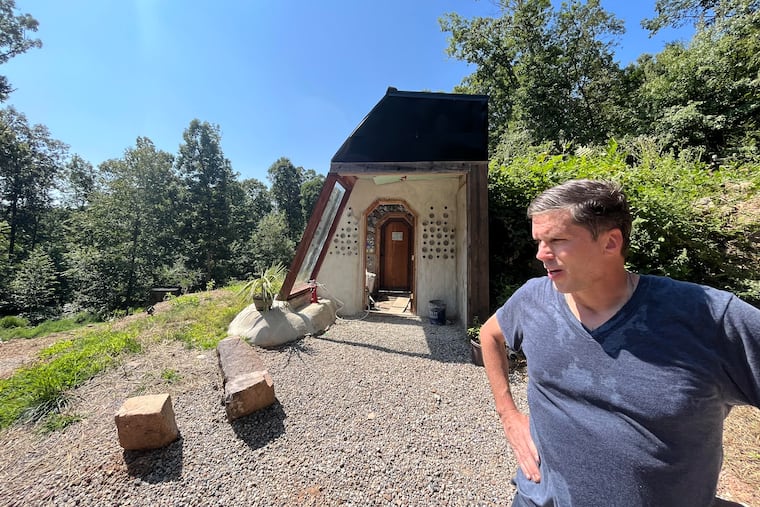He’s building a glass ‘Hobbit’-like home in Pa. coal country
The Tamaqua Sustainability Project, in Schuylkill County, is an off-grid home inspired by designs in the desert of New Mexico.

TAMAQUA, Pa. — At first glance, the long glass building on a sun-soaked hillside in this rural Schuylkill County town is obviously a greenhouse.
It’s a home too, though, in the vein of The Hobbit, or will be in a few more years, builder Will Vogler said. It’s also a natural heating and cooling system and a water filtration plant off the grid, in the woods. Vogler calls his 80-foot-by-50-foot building the “Tamaqua Sustainability Project,” inspired by a decades-old architecture developed in the high desert of New Mexico.
“When I look at it, I see an engine, ” the Ambler resident said beside his project.
That’s what Mike Reynolds, a 78-year-old architect, intended when he created the first “Earthship” with old beer cans and used tires in Taos in 1979.
People made fun of his dream for decades.
“I was the crazy hippie in the desert building houses out of garbage,” Reynolds told The Inquirer. “I was ridiculed and abused. I even lost my architecture license in one state.”
A combination of climate change, catastrophic weather events, water scarcity, and power grid failures have cast the Earthship “biotecture” in a new light, however. Reynolds said there’s about 3,000 already built, globally, some as far as New Zealand and Australia. He’s still building more in a 630-acre subdivision in Taos and said they’re all sold before they’re finished.
“The world went to hell in a handbag and people began to look to us for an alternative,” he said.
Today, Reynolds thinks there’s no structure better designed to combat climate change and survive in it than the Earthship.
Bad weather and power outages compelled Vogler, a father of three who works in software, to delve into sustainable living.
“Hurricane Sandy, in particular, was really eye-opening,” he said. “It seemed like there was quite a few storms for a time, one after another. We live in a wooded area and having our power going out all the time had me thinking there has to be a better way.”
Vogler, a Penn State graduate, dabbled in generators but was surprised at how little they could actually power. He hired organic farmers to turn his backyard into an edible landscape and, after learning about Earthship biotecture picked their brains about building a greenhouse in that style.
“They had no clue what I was talking about,” he said.
Vogler kept researching and connected with seasoned Earthship builders who helped get his project off the ground, or rather, into it. Vogler, 47, and his father, Bill, purchased the 18 acres in Tamaqua about three years ago.
The permitting and code process has moved slowly, he said. Few officials have seen an Earthship, he said, or dealt with builders who don’t want to connect to the grid.
“It’s just as much a learning process for them,” he said.
Vogler has spent about $100,000, recently installing a septic system. He also created a GoFundMe and urges volunteers to visit the property, both for the labor and to learn.
On this warm Sunday afternoon, a handful of people had traveled to Tamaqua to help Vogler build air intake tunnels with concrete and cans. The tunnels pull in cooler air, pushing the heat out of vents on the Earthship’s roof, making the interior much cooler than expected.
Many of the volunteers were interested going off-grid for good, or having a getaway if needed.
“There’s honestly not a lot of places in Pennsylvania where you can learn how to do this,” said Buddy Light, a Montgomery County native interested in building an Earthship.
The goal of any Earthship, Vogler said, is to be self-sustaining, with building materials that are recycled. If it’s an engine, it runs on the air, rain, wind, and dirt. He doesn’t consider his project an official Earthship because he isn’t using tires in his building. (The tires make great insulation.) He does have a plenty of cans, though, and walls made of old bottles and cement.
“You’d be crazy to build an Earthship without a bottle wall,” he said.
Vogler is hoping to sell off some parcels to like-minded buyers interested in building Earthships too. Those funds would help him finish the project.
“We want to create a community,” he said. “At least three to five other projects here.”
Reynolds doesn’t trademark his idea or even ask for licensing fees. He wants the information to spread, “like a virus.”
“People are coming out here in droves from the cities,” he said. “It used to be young hipsters but now it’s conservatives, wealthy families too. Everybody is insecure about the state of things.”
Reynolds said the Earthships are too expensive right now, often selling for up to $800,000.
“My whole financial model is treading water. I’m not trying to make a billion dollars,” he said. “I’ve got to have a fleet on the market for under $400,000 or $300,000. We’re going to get into a lease program too.”
For Vogler, the goal is to live in his Earthship with his family when it’s done.
“It’s odd, really, that more people aren’t doing this,” he said. “This honestly feels like the most rebellious thing I could do.”